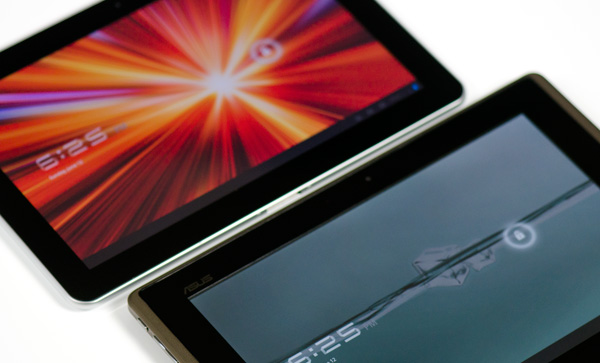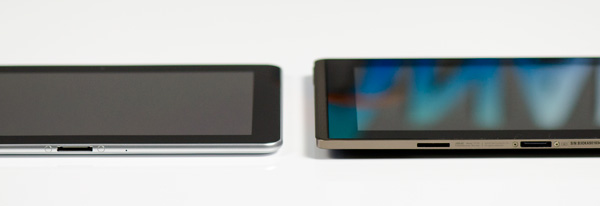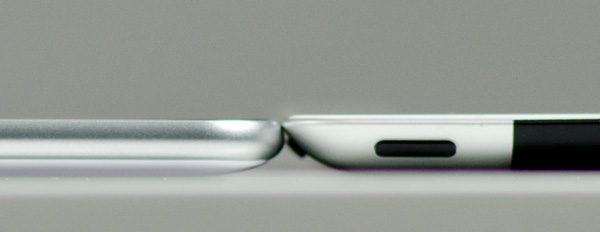Samsung Galaxy Tab 10.1 Review: The Sleekest Honeycomb Tablet
by Anand Lal Shimpi on June 13, 2011 5:07 AM EST- Posted in
- Tablets
- Samsung
- Tegra 2
- Galaxy tab 10.1
- Android 3.1
- Mobile
- NVIDIA
I remember standing in the audience of Samsung's CTIA press conference as it announced, for the first time ever, pricing and availability of its unreleased Galaxy Tab 10.1 and 8.9 before shipping. The smartphone (and early tablet) industries have gone this long without having to really compete based on price, mostly because in North America the carriers subsidize much of the cost. If every device costs $199 under contract, why get carried away with details like how much it actually costs?
The Galaxy Tab however was playing in a different space. While Apple ultimately caved to the pressures of carrier subsidies with the iPhone, the iPad remains completely unsubsidized and its followers buy it by the millions. The magical price point is $499 and it was at Samsung's CTIA press conference that it announced it would be matching Apple's $499 price point, and even dropping slightly below it for the 8.9-inch version.
At the time it seemed like a bold move, enough to give Honeycomb the fighting chance it needed. The Galaxy Tab would be thinner and lighter than the iPad 2 but competitively priced as well. This wouldn't be another Xoom.

Samsung Galaxy Tab 10.1 (top) vs. ASUS Eee Pad Transformer (bottom)
Then ASUS showed up. At $399, the Eee Pad Transformer not only offered a different usage model to the iPad and Galaxy Tab, it brought a lower price tag as well. Availability has been slim thanks to component shortages, but with the Eee Pad selling for $399 the Galaxy Tab at $499 all of the sudden seems overpriced.
| 2011 Tablet Comparison | ||||||
| Apple iPad 2 | ASUS Eee Pad Transformer | Motorola Xoom WiFi | Samsung Galaxy Tab 10.1 | |||
| SoC | Apple A5 (Dual ARM Cortex A9 @ 1GHz) | NVIDIA Tegra 2 (Dual ARM Cortex A9 @ 1GHz) | NVIDIA Tegra 2 (Dual ARM Cortex A9 @ 1GHz) | NVIDIA Tegra 2 (Dual ARM Cortex A9 @ 1GHz) | ||
| GPU | PowerVR SGX 543MP2 | NVIDIA GeForce | NVIDIA GeForce | NVIDIA GeForce | ||
| RAM | 512MB | 1GB | 1GB | 1GB | ||
| Display | 1024 x 768 IPS | 1280 x 800 IPS | 1280 x 800 | 1280 x 800 PLS | ||
| NAND | 16GB | 16GB | 32GB | 16GB | ||
| Dimensions | 241.2mm x 185.7mm x 8.8mm | 271mm x 175mm x 12.95mm | 249.1mm x 167.8mm x 12.9mm | 256.6 x 172.9 x 8.6mm | ||
| Weight | 601g | 695g | 730g | 565g | ||
| Price | $499 | $399 | $599 | $499 | ||
Based on specs alone you'd be right. Samsung's Galaxy Tab 10.1 has the same NVIDIA Tegra 2 tablet SoC inside,
1GB of LPDDR2 and 16GB of NAND on-board. You get a 10.1-inch 1280 x 800 PLS display and 802.11n WiFi support. It's worth pointing out that we're now well into the month of June and NVIDIA continues to be the only SoC vendor shipping in Honeycomb tablets. Samsung originally had plans to ship its own Exynos SoC in the Galaxy Tab but Tegra 2 remains the port of choice for all Honeycomb vendors at this point. Whether or not NVIDIA can win twice in a row with Ice Cream Sandwich later this year remains to be seen.

Samsung Galaxy Tab 10.1 (left) vs. ASUS Eee Pad Transformer (Right)
Where Samsung gives you something more for your money is in build quality and form factor. While Eee Pad Transformer feels surprisingly good for a cost reduced tablet, it doesn't feel nearly as slim or portable as the Galaxy Tab 10.1. It's no wonder Samsung went back to the drawing board on this one, the result is something that in many ways feels better than the iPad 2.
Apple still gets the nod in terms of quality of materials. The aluminum back of the iPad 2 is unbeatable. The Galaxy Tab 10.1 however feels lighter, a bit more rugged (I'm less concerned about scratching plastic than I am marring aluminum) and a little more comfortable to hold as a result. Against the Eee Pad there's no competition. I can live with the Eee Pad, but I much prefer the feel of the Galaxy Tab 10.1. The new Tab just feels like a device from this year - a compliment that, until now, I had only given to Apple.
The Galaxy Tab 10.1 measures just 8.6mm thick, 0.2mm thinner than the iPad 2. To be honest you really can't tell the difference, both devices feel thin. Ever after holding them back to back it's near impossible to tell that Samsung has built a thinner device. The most tangible difference in feel is the weight, not just in overall mass but in terms of weight distribution. The Galaxy Tab seems to carry the weight a bit better than the iPad, a bit more evenly.

Samsung Galaxy Tab 10.1 (left) vs. Apple iPad 2 (right)
Now is as good a time as any to point out that although Samsung calls this the Galaxy Tab 10.1, it's really the new Galaxy Tab 10.1. Originally Samsung announced a much thicker version at Mobile World Congress, a month prior to the CTIA announcement. With the much thinner iPad 2 hitting the market after the original 10.1 announcement, Samsung scrapped plans for the original and unveiled the thinner 8.6mm version as the new Galaxy Tab. The original Galaxy Tab 10.1 is now known as the Galaxy Tab 10.1v.












108 Comments
View All Comments
fteoath64 - Wednesday, June 15, 2011 - link
I doubt if Samsung knew very much detail about the physical shape (although they could guess and many have done), panel size and dot-pitch yes, processor no, camera no (its Sony's part), but that hardly constitute "blatant copying" as Apple has accused. One cannot deviate much from a rectangular shape. But the thing that cannot understand is no manufacturer has built rocker switches (like in PocketPC days) that does vertical/horizontal scrolling. This allows the single holding hand to scroll pages which EVERYBODY wanted!!. Samsung are you listening ?. One for landscape use and one for portrait use. There is plenty of space for it. Touch is not everything.Lucian Armasu - Tuesday, June 14, 2011 - link
"Remember Kal-El won't really change single threaded performance"I think I know what you meant - that it would still be Cortex A9. But that doesn't mean performance won't improve. Every core will be clocked at 1.5 Ghz.
And you're right, ARM chips seem to improve 2.5x every 12 months, or about 4x every 18-24 months. That's 2x as fast as Moore's Law. Can't wait until Nvidia unveils their Tegra 4 next year - 2.5 Ghz quad core Cortex A15 ;)
mo.hasan - Tuesday, June 14, 2011 - link
Anand. Very thorough review as always. Great job.Here is a list of accessories available for Samsung 10.1. Currently they are showing up on european websites. Landing in USA soon I suppose.
HDMI cable adapter
SD Adapter
Charging Dock with sound bar
USB Connector Kit
Keyboard
More...
Yes you can have all these ports built in like an Acer Iconia or some in Asus Transformer. Personally I will take the weight savings and slimness versus all those ports built in. In a tablet that is. Notebook however is a whole different story. Plus Samsung's superior display is a slam dunk for me versus any other android tablet at the moment. Kal-El is not worth waiting for unless you are buying a tablet to play games only. Damn you Bestbuy, here is my pre-order.
Mumrik - Tuesday, June 14, 2011 - link
Anand, why does Apple keep having a sizable advantage in battery life? It's the same in tablets and smart phones...The hardware seems to similar to blame, so does Google just do a comparatively bad job at managing power in Android?
Paladin1650 - Wednesday, June 15, 2011 - link
I don't understand the fixation on 10 inch tablets. That is too big to be easily portable without carrying a bag everywhere, and if I'm toting a bag, I might as well bring a laptop with a bigger screen, real keyboard, 300gig+ hard drive, real operating system, real processor, etc. Not to mention the built in stand. My 15 inch laptop is not much thicker or heavier than an iPad.Its too big, bright, and heavy to use like a portable game console or an e-reader (Note: Nintendo never came anywhere close to a 10 inch screen on any of its 50 million plus selling portable consoles). Sure you can goof around on it and have unique experiences...but those experiences aren't going to be lasting dozens of hours like a novel or a serious video game.
Are people actually trying to replace their laptop with a tablet? That is the only usage scenario that makes sense to me for a 10 inch tablet. If you are somehow able to actually type and be productive on a tablet, more power to you.
Now, what DOES make sense to me is a giant smartphone. Smartphones are incredibly useful, more useful for everyday tasks than a laptop, since it has GPS, camera, camcorder, barcode scanner, phone, email, MP3 player etc all rolled into one. However, a 3-4 inch screen is really too small for video content consumption, and doesn't allow much room for touch. Solution? A 5-6 inch jumbo smartphone that behaves exactly like a smartphone, but with a bigger screen. That is what I want (the original galaxy tab comes close, but a bit too large to be pocket sized). So why are we only seeing those from Dell and Samsung, and why does Samsung seem to be switching to larger form-factors? Why is "its just a giant phone" a bad thing? I think in 10 years we will see this size range emerge as the standard for the all-in-one pocket device, and the 10 inch tablet will remain a very niche product.
fteoath64 - Wednesday, June 15, 2011 - link
@Paladin1650: When you look at the kindle, it gives a strong clue. Besides to consume 720p video, 10 inch is about the ,minimum needed to appreciate the quality of the video. Anything smaller, 720p is not going to matter much. For eBook reading and that goes for webpage reading as well, that physical size is really optimum for most people young and old. My only beef is the screen resolution should be 1366X768 and make that IPS at least.Laptop usage is different from tablet significantly from the holding distance from your face to the screen. On a tablet, you hold it much nearer to your face. This means 10inches could instantly equal to 15inch laptop distance. Plus the weight advantage and not frying your lap scenarios, it could be compelling for some.
As to phones going to 5inches, thats already too big for many. iPhone size is about right, and going to 4 inches might be pushing it. I like to see 1680X1050 resolution in 4 inches.
One size fits all does not exist unless thats a body implant using our body fluids as its electrical source. Get that from your friendly grey alien Paul.
araczynski - Wednesday, June 15, 2011 - link
but no point in buying until the second gen comes out later this year, especially since ipad3 will hopefully share some info by then.i'm heavily vested in the itunes app store (i use my ipad1 95% of the time for just gaming), so whatever other neato features the android tablets have are meaningless to me. especially since if i read those last 2 benchmarks the gaming on the android doesn't compare to the gaming on the ipad2.
i still think they're stupid to price it at the same level as the ipads though. you're going against an entrenched/established and in many cases fanatical base of apple users (i have no love for apple, but do love the ipad), you deliver something similar, and you charge it the same, why the hell would i bother to switch? offer me something BETTER.
not to mention 16/32gb of storage is just measly. this IS the digital age after all, we like to dump movies/etc onto these devices. my ipad/64gb is full all the time, and i'm sick of that fact. no way in hell would i downgrade storage.
ps2 - Thursday, June 16, 2011 - link
So, having read this review, it sounds like I would best wait another 6 months to own a tablet. I am getting a galaxy S2 phone in about 6 weeks when it is released, so i probably should wait, but my partner has an IPad 2 and I could have a tablet by tomorrow (I think that's when the 10.1 is being released). Is it worth 5 or $600 to have a tablet for the next six months? I know it's my decision, but I welcome some brilliant geeks advice.ps2 - Thursday, June 16, 2011 - link
So, having read this review, it sounds like I would best wait another 6 months to own a tablet. I am getting a galaxy S2 phone in about 6 weeks when it is released, so i probably should wait, but my partner has an IPad 2 and I could have a tablet by tomorrow (I think that's when the 10.1 is being released). Is it worth 5 or $600 to have a tablet for the next six months? I know it's my decision, but I welcome some brilliant geek's advice. And if I am likely to upgrade in the future (if I buy a tablet now, I won't feel an urge to buy a Kel-al device the second it comes out), should my purchase be an IPad 2 or Galaxy 10.1 (or should I wait two months for an 8.9)?emmib - Friday, June 17, 2011 - link
Would Kal-El seriously make it to market, in an Android tablet, within the next 4-5 months? The best scenario I can see is an announcement in 4 months time, in the fall, then release either by the holiday season, or within a couple of months after that.What's truly best? Wait, or get a tablet now? I don't really care for graphics performance as not many games and such are available in my region anyway.